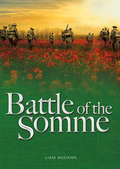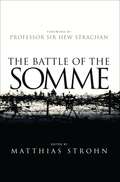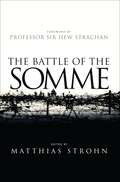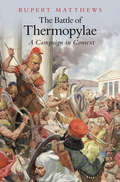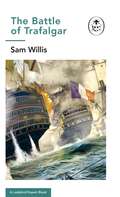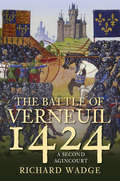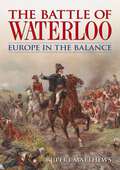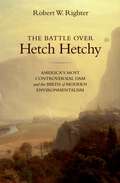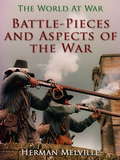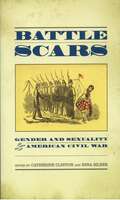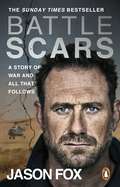- Table View
- List View
Battle of the Somme
by Liam McCannThe offensive on the Somme took place between July 1 and November 18 1916 and is arguably the most iconic battle of the Great War. Kitchener’s infamous Pals Battalions were first sent into the battlefield en masse and it was a here where many of the dreams and aspirations of a nation, hopeful of victory, were agonizingly dashed. More than three million men fought in the battle and one million men were wounded or killed, making it one of the bloodiest battles in history.
The Battle of the Somme
by Hew Strachan Jonathan Krause Matthias StrohnPublished to coincide with the centenary commemoration of the battle of the Somme, this new study comprises 12 separate articles written by some of the foremost military historians, each of whom looks at a specific aspect of the battle. Focusing on key aspects of the British, French and German forces, overall strategic and tactical impacts of the battle and with an introduction by renowned World War I scholar Professor Sir Hew Strachan, The Battle of the Somme is a timely collection of the latest research and analysis of the battle.The terrors of the Somme have largely come to embody trench warfare on the Western Front in the modern imagination, but this new book looks beyond the horrendous conditions and staggering casualty rates to provide new, insightful research on one of the most pivotal battles of the war.
The Battle of the Somme
by Sir Hew Strachan Dr Jonathan Krause Matthias StrohnPublished to coincide with the centenary commemoration of the battle of the Somme, this new study comprises 12 separate articles written by some of the foremost military historians, each of whom looks at a specific aspect of the battle. Focusing on key aspects of the British, French and German forces, overall strategic and tactical impacts of the battle and with an introduction by renowned World War I scholar Professor Sir Hew Strachan, The Battle of the Somme is a timely collection of the latest research and analysis of the battle.The terrors of the Somme have largely come to embody trench warfare on the Western Front in the modern imagination, but this new book looks beyond the horrendous conditions and staggering casualty rates to provide new, insightful research on one of the most pivotal battles of the war.
The Battle of the Styles: Society, Culture and the Design of a New Foreign Office, 1855-1861
by Bernard PorterThe present-day Foreign Office in Whitehall is an imposing building whose genesis is bizarre. In 1857 a competition was held to pick an architect, which provoked a huge row between the rival 'Classical' and 'Gothic' schools, which a 'Goth' (George Gilbert Scott) won – but was then forced to re-design in Classical. The circumstances surrounding this fiasco furnish the starting-point for this book; which then goes on to analyse the debate that preceded this decision, for the light it sheds on the complex nature of British culture and society then. Among issues raise were contemporary and conflicting understandings of Britain's (or England's) national and imperial identities; of religion and morality; of history, 'modernity' and 'progress'; and of class and gender. The debate offers an unusual insight into the relationship between all these matters and 'high culture' generally. This account of it should be of great value to cultural and social historians, as well as to any architectural historians interested in the broader historical context surrounding this and other great monuments of the time.
The Battle of the Styles: Society, Culture and the Design of a New Foreign Office, 1855-1861
by Bernard PorterThe present-day Foreign Office in Whitehall is an imposing building whose genesis is bizarre. In 1857 a competition was held to pick an architect, which provoked a huge row between the rival 'Classical' and 'Gothic' schools, which a 'Goth' (George Gilbert Scott) won – but was then forced to re-design in Classical. The circumstances surrounding this fiasco furnish the starting-point for this book; which then goes on to analyse the debate that preceded this decision, for the light it sheds on the complex nature of British culture and society then. Among issues raise were contemporary and conflicting understandings of Britain's (or England's) national and imperial identities; of religion and morality; of history, 'modernity' and 'progress'; and of class and gender. The debate offers an unusual insight into the relationship between all these matters and 'high culture' generally. This account of it should be of great value to cultural and social historians, as well as to any architectural historians interested in the broader historical context surrounding this and other great monuments of the time.
The Battle of the Sun
by Jeanette WintersonJack is the chosen one, the Radiant Boy the Magus needs in order to perfect the alchemy that will transform London of the 1600s into a golden city.But Jack isn't the kind of boy who will do what he is told by an evil genius, and he is soon involved in an epic and nail-biting adventure, featuring dragons, knights and Queen Elizabeth I, as he battles to save London.Jeanette Winterson's first novel for children, Tanglewreck, was widely admired. Here in her second, readers will once more relish her free-spirited literary inventiveness and style.
The Battle of Thermopylae: A Campaign in Context (Campaign In Context Ser.)
by Rupert Matthews‘Tell the Spartans, stranger passing by, that here obedient to their laws we lie.’ One of the most remarkable actions in ancient or modern military history took place at Thermopylae in 480BC. Rupert Matthews has personally examined the battlefield in order to try to explain how 300 Spartans could hold at bay the hordes of the Persian Emperor Xerxes. This was no vain sacrifice; the delay gave breathing space for the Greek states to organise their defence, and ultimately defend successfully their homelands. Among other intriguing revelations the author explains the importance of the half-ruined wall that sheltered the Spartans against the onslaught. With concise diagrams and maps of the entire campaign, the reader can begin to understand the extraordinary, apparently impossible outcome of the war.
Battle of Trafalgar: A Ladybird Expert Book (The Ladybird Expert Series #28)
by Sam WillisPart of the ALL-NEW LADYBIRD EXPERT SERIES- Why was the Battle of Trafalgar such an important British victory in the Napoleonic Wars? - How did the British fleet show their strength against the French and Spanish? - How did Nelson excel in his final battle?FOLLOW the daring strategy and brilliant leadership of Horatio Nelson in Britain's stunning triumph against Napoleon's forces. From the might of Britain's war machine to the death of the world's most impressive naval commander, discover why Trafalgar remains the most famous naval battle in history.BRITAIN'S GLORIOUS VICTORY, AND NELSON'S FINAL BATTLEWritten by historian, archaeologist, and broadcaster Sam Willis, The Battle of Trafalgar is gripping and accessible introduction to the battle that established Britain as a formidable seapower for many years to come.
The Battle of Verneuil 1424: A Second Agincourt
by Richard WadgeIn August 1424 the armies of England, Scotland and France met in the open fields outside the walls of Verneuil in a battle that would decide the future of the English conquests in France. The hero king, Henry V, had been dead for two years and the French felt that this was their chance to avenge their startling defeat at Agincourt, and recover the lands that Henry had won for England. Despite its importance, the battle is largely overlooked in accounts of the Hundred Years War. The Battle of Verneuil 1424 is the first proper account of the battle, and is also one of the first books to outline the important part the Scots played in the wars in France in the years between the two great battles of Agincourt and Verneuil.
The Battle of Waterloo: Europe in the Balance
by Rupert MatthewsThe Battle of Waterloo was one of the most dramatic and decisive battles ever fought. It marked the bloody end of the long struggle between the new ideals of the French Revolution and the established orders that had begun in 1793, and ushered in a century of peace in Europe.For such a massively important battle, Waterloo is all too often misunderstood, probably because the combatants have concentrated on the role of their own troops. Going back to the original sources, the author looks at the day of battle as a whole, delving behind the headline events to reveal why the battle unfolded as it did.
The Battle of Waterloo (General Military Ser.)
by Bloomsbury PublishingFrom the team that brought you the bestselling Bradshaw's Handbook comes another fantastic facsimile reproduction – The Battle of Waterloo. First published in the months after the battle, this unique title gives an unprecedented glimpse into how the battle of Waterloo was viewed in its immediate aftermath. Published to coincide with the 200th anniversary of the battle, this is a collection of reports of the battle from all sides, records of the orders issued to both armies, the official gazette sent by Wellington, the firsthand accounts of French marshals, sobering lists of those killed in the battle, the obituaries of key figures, a full narrative description of the battle and interpretations of the battle on the ground, including letters from the Duke of Wellington. Two beautifully detailed concertinafold maps and a detailed panorama of the battlefield, hand drawn by a survivor of the battle, complete this incredible collection.
The Battle of Waterloo
by Bloomsbury PublishingFrom the team that brought you the bestselling Bradshaw's Handbook comes another fantastic facsimile reproduction – The Battle of Waterloo. First published in the months after the battle, this unique title gives an unprecedented glimpse into how the battle of Waterloo was viewed in its immediate aftermath. Published to coincide with the 200th anniversary of the battle, this is a collection of reports of the battle from all sides, records of the orders issued to both armies, the official gazette sent by Wellington, the firsthand accounts of French marshals, sobering lists of those killed in the battle, the obituaries of key figures, a full narrative description of the battle and interpretations of the battle on the ground, including letters from the Duke of Wellington. Two beautifully detailed concertinafold maps and a detailed panorama of the battlefield, hand drawn by a survivor of the battle, complete this incredible collection.
The Battle over America's Origin Story: Legends, Amateurs, and Professional Historiographers
by Brian RegalThis book examines the legends of who ‘really’ discovered America. It argues that histories of America's origins were always based less on empirical evidence and more on social, political, and cultural wish fulfillment. Influenced by a complex interplay of Nativist hatred of immigrants and Aboriginal people, as well as distrust of academic scholarship, these legends ebbed and flowed with changing conditions in wider American society. The book focuses on the actions of a collection of quirky, obsessed amateur investigators who spent their lives trying to prove their various theories by promoting Welsh princes, Vikings, Chinese admirals, Neo-lithic Europeans, African explorers, and others who they say arrived centuries before Columbus. These myths acted as mitigating agencies for those who embraced them. Along with recent scholarship, this book makes extensive use of archival materials—some of which have never been employed before. It covers the period from the sixteenth century to the present. It brings together separate historiographic ideas to create a unified history rather than focusing on one particular legend as most books on the subject do. It shows how questions of who discovered America helped create the field of historical scholarship in this country. This book does not attempt to prove who discovered America, rather it tells the story of those who think they did.
The Battle over Hetch Hetchy: America's Most Controversial Dam and the Birth of Modern Environmentalism
by Robert W. RighterIn the wake of the devastating 1906 earthquake and fire, the city of San Francisco desperately needed reliable supplies of water and electricity. Its mayor, James Phelan, pressed for the damming of the Tuolumne River in the newly created Yosemite National Park, setting off a firestorm of protest. For the first time in American history, a significant national opposition arose to defend and preserve nature, led by John Muir and the Sierra Club, who sought to protect what they believed was the right of all Americans to experience natural beauty, particularly the magnificent mountains of the Yosemite region. Yet the defenders of the valley, while opposing the creation of a dam and reservoir, did not intend for it to be maintained as wilderness. Instead they advocated a different kind of development--the building of roads, hotels, and an infrastructure to support recreational tourism. Using articles, pamphlets, and broadsides, they successfully whipped up public opinion against the dam. Letters from individuals began to pour into Congress by the thousands, and major newspapers published editorials condemning the dam. The fight went to the floor of Congress, where politicians debated the value of scenery and the costs of western development. Ultimately, passage of the passage of the Raker Act in 1913 by Congress granted San Francisco the right to flood the Hetch Hetchy Valley. A decade later the O'Shaughnessy Dam, the second largest civil engineering project of its day after the Panama Canal, was completed. Yet conflict continued over the ownership of the watershed and the profits derived from hydroelectrocity. To this day the reservoir provides San Francisco with a pure and reliable source of drinking water and an important source of power. Although the Sierra Club lost this battle, the controversy stirred the public into action on behalf of national parks. Future debates over dams and restoration clearly demonstrated the burgeoning strength of grassroots environmentalism. In a narrative peopled by politicians and business leaders, engineers and laborers, preservationists and ordinary citizens, Robert W. Righter tells the epic story of the first major environmental battle of the twentieth century, which reverberates to this day.
The Battle over Hetch Hetchy: America's Most Controversial Dam and the Birth of Modern Environmentalism
by Robert W. RighterIn the wake of the devastating 1906 earthquake and fire, the city of San Francisco desperately needed reliable supplies of water and electricity. Its mayor, James Phelan, pressed for the damming of the Tuolumne River in the newly created Yosemite National Park, setting off a firestorm of protest. For the first time in American history, a significant national opposition arose to defend and preserve nature, led by John Muir and the Sierra Club, who sought to protect what they believed was the right of all Americans to experience natural beauty, particularly the magnificent mountains of the Yosemite region. Yet the defenders of the valley, while opposing the creation of a dam and reservoir, did not intend for it to be maintained as wilderness. Instead they advocated a different kind of development--the building of roads, hotels, and an infrastructure to support recreational tourism. Using articles, pamphlets, and broadsides, they successfully whipped up public opinion against the dam. Letters from individuals began to pour into Congress by the thousands, and major newspapers published editorials condemning the dam. The fight went to the floor of Congress, where politicians debated the value of scenery and the costs of western development. Ultimately, passage of the passage of the Raker Act in 1913 by Congress granted San Francisco the right to flood the Hetch Hetchy Valley. A decade later the O'Shaughnessy Dam, the second largest civil engineering project of its day after the Panama Canal, was completed. Yet conflict continued over the ownership of the watershed and the profits derived from hydroelectrocity. To this day the reservoir provides San Francisco with a pure and reliable source of drinking water and an important source of power. Although the Sierra Club lost this battle, the controversy stirred the public into action on behalf of national parks. Future debates over dams and restoration clearly demonstrated the burgeoning strength of grassroots environmentalism. In a narrative peopled by politicians and business leaders, engineers and laborers, preservationists and ordinary citizens, Robert W. Righter tells the epic story of the first major environmental battle of the twentieth century, which reverberates to this day.
The Battle over Patents: History and Politics of Innovation
by Stephen H. Haber and Naomi R. LamoreauxAn examination of how the patent system works, imperfections and all, to incentivize innovation Do patents facilitate or frustrate innovation? Lawyers, economists, and politicians who have staked out strong positions in this debate often attempt to validate their claims by invoking the historical record--but they frequently get the history wrong. The Battle over Patents gets it right. Bringing together thoroughly researched essays from prominent historians and social scientists, this volume traces the long and contentious history of patents and examines how they have worked in practice. Editors Stephen H. Haber and Naomi R. Lamoreaux show that patent systems are the result of contending interests at different points in production chains battling over economic surplus. The larger the potential surplus, the more extreme are the efforts of contending parties-now and in the past-to search out, generate, and exploit any and all sources of friction. Patent systems, as human creations, are therefore necessarily ridden with imperfections. This volume explores these shortcomings and explains why, despite all the debate, historically US-style patent systems still dominate all other methods of encouraging inventive activity.
The Battle over Patents: History and Politics of Innovation
An examination of how the patent system works, imperfections and all, to incentivize innovation Do patents facilitate or frustrate innovation? Lawyers, economists, and politicians who have staked out strong positions in this debate often attempt to validate their claims by invoking the historical record--but they frequently get the history wrong. The Battle over Patents gets it right. Bringing together thoroughly researched essays from prominent historians and social scientists, this volume traces the long and contentious history of patents and examines how they have worked in practice. Editors Stephen H. Haber and Naomi R. Lamoreaux show that patent systems are the result of contending interests at different points in production chains battling over economic surplus. The larger the potential surplus, the more extreme are the efforts of contending parties-now and in the past-to search out, generate, and exploit any and all sources of friction. Patent systems, as human creations, are therefore necessarily ridden with imperfections. This volume explores these shortcomings and explains why, despite all the debate, historically US-style patent systems still dominate all other methods of encouraging inventive activity.
Battle-Pieces and Aspects of the War: Civil War Poems (The World At War)
by Herman MelvilleBattle-Pieces and Aspects of the War (1866) is the first book of poetry published by American author Herman Melville. The volume is dedicated "To the Memory of the Three Hundred Thousand Who in the War For the Maintenance of the Union Fell Devotedly Under the Flag of Their Country" and its 72 poems deal with the battles and personalities of the American Civil War and their aftermath. (Excerpt from Wikipedia)
The Battle Rhetoric of Crusade and Holy War, c. 1099–c. 1222 (Advances in Crusades Research)
by Connor Christopher WilsonThis book examines Latin narratives produced in the aftermath of the First Crusade and challenges the narrative of supposed brutality and amorality of warfare in this period--instead focusing on the moral and didactic concerns surrounding warfare and violence with which medieval authors wrestled. The battle oration, a rousing harangue exhorting warriors to deeds of valour, has been regarded as a significant aspect of warfare since the age of Xenophon, and has continued to influence conceptions of campaigning and combat to the present day. While its cultural and chronological pervasiveness attests to the power of this trope, scholarly engagement with the literary phenomenon of the pre-battle speech has been limited. Moreover, previous work on medieval battle rhetoric has only served to reinforce the supposed brutality and amorality of warfare in this period, highlighting appeals to martial prowess, a hatred for ‘the enemy’ and promises of wealth and glory. This book, through an examination of Latin narratives produced in the aftermath of the First Crusade and the decades that followed, challenges this understanding and illuminates the moral and didactic concerns surrounding warfare and violence with which medieval authors wrestled. Furthermore, while battle orations form a clear mechanism by which the fledgling crusading movement could be explored ideologically, this comparative study reveals how non-crusading warfare in this period was also being reconceptualised in light of changing ideas about just war, authority and righteousness in Christian society. This volume is perfect for researchers, students and scholars alike interested in medieval history and military studies.
The Battle Rhetoric of Crusade and Holy War, c. 1099–c. 1222 (Advances in Crusades Research)
by Connor Christopher WilsonThis book examines Latin narratives produced in the aftermath of the First Crusade and challenges the narrative of supposed brutality and amorality of warfare in this period--instead focusing on the moral and didactic concerns surrounding warfare and violence with which medieval authors wrestled. The battle oration, a rousing harangue exhorting warriors to deeds of valour, has been regarded as a significant aspect of warfare since the age of Xenophon, and has continued to influence conceptions of campaigning and combat to the present day. While its cultural and chronological pervasiveness attests to the power of this trope, scholarly engagement with the literary phenomenon of the pre-battle speech has been limited. Moreover, previous work on medieval battle rhetoric has only served to reinforce the supposed brutality and amorality of warfare in this period, highlighting appeals to martial prowess, a hatred for ‘the enemy’ and promises of wealth and glory. This book, through an examination of Latin narratives produced in the aftermath of the First Crusade and the decades that followed, challenges this understanding and illuminates the moral and didactic concerns surrounding warfare and violence with which medieval authors wrestled. Furthermore, while battle orations form a clear mechanism by which the fledgling crusading movement could be explored ideologically, this comparative study reveals how non-crusading warfare in this period was also being reconceptualised in light of changing ideas about just war, authority and righteousness in Christian society. This volume is perfect for researchers, students and scholars alike interested in medieval history and military studies.
Battle Royal: The Wars of Lancaster and York, 1450-1462
by Hugh BichenoEngland, 1454. A kingdom sliding into chaos. The mentally unstable King Henry VI, having struggled for a decade to contain the violent feuding of his magnates, loses his mind. Disgruntled nobles back the regal claims of Richard, Duke of York, great-grandson of Edward III. The stage is set for civil war. The first volume of an enthralling two-part history of the dynastic wars fought between the houses of Lancaster and York, Battle Royal traces the conflict from its roots in the 1440s to the early 1460s – a period marked by the rise and fall of Richard of York, the deposition of Henry VI following the Lancastrian defeat at Towton, and the subsequent seizure of his throne by Richard's son Edward. Populating this late-medieval saga of ambition, intrigue and bloodshed are such fascinating characters as the vacillating Henry himself, his indefatigable queen Marguerite of Anjou, Richard of York (father of kings but never king himself),his opportunist ally Richard Neville, 'the Kingmaker', and the precociously virile Edward of York. Charting a clear course through the dynastic and factional complexities of fifteenth-century power politics, and offering crisply authoritative analysis of the key battles of the Wars of the Roses, Battle Royal is a compelling and rigorously researched account of England's longest and bloodiest civil war.
Battle-scarred: Mortality, medical care and military welfare in the British Civil Wars (Politics, Culture and Society in Early Modern Britain)
by David J. Appleby Andrew HopperBattle-Scarred investigates the human costs of the British Civil Wars. Through a series of varied case studies it examines the wartime experience of disease, burial, surgery and wounds, medicine, hospitals, trauma, military welfare, widowhood, desertion, imprisonment and charitable endeavour. These issues demand our attention because the percentage population loss in these conflicts was far higher than during the two World Wars, rendering the Civil Wars arguably the most unsettling experience the British peoples have ever undergone. This volume will explore these themes from these varied new angles, drawing upon the insights shared at the inaugural conference of the National Civil War Centre in August 2015, and since developed further in the Centre’s well-received ‘Battle-Scarred’ exhibition on the same theme. This volume shows how military history is broadening its remit, and reaching out to new audiences.
Battle-scarred: Mortality, medical care and military welfare in the British Civil Wars (Politics, Culture and Society in Early Modern Britain)
by Jason PeaceyBattle-scarred investigates the human costs of the British Civil Wars. Through a series of varied case studies it examines the wartime experience of disease, burial, surgery and wounds, medicine, hospitals, trauma, military welfare, widowhood, desertion, imprisonment and charity. The percentage population loss in these conflicts was far higher than that of the two World Wars, which renders the Civil Wars arguably the most unsettling experience the British people have ever undergone. The volume explores its themes from new angles, demonstrating how military history can broaden its perspective and reach out to new audiences.
Battle Scars: Gender and Sexuality in the American Civil War
by Catherine Clinton Nina SilberOver a decade ago, the publication of Divided Houses ushered in a new field of scholarship on gender and the Civil War. Following in its wake, Battle Scars showcases insights from award-winning historians as well as emerging scholars. This volume depicts the ways in which gender, race, nationalism, religion, literary culture, sexual mores, and even epidemiology underwent radical transformations from when Americans went to war in 1861 through Reconstruction. Examining the interplay among such phenomena as racial stereotypes, sexual violence, trauma, and notions of masculinity, Battle Scars represents the best new scholarship on men and women in the North and South and highlights how lives were transformed by this era of tumultuous change.
Battle Scars: The Sunday Times bestseller
by Jason FoxTHE EXTRAORDINARY NUMBER ONE BESTSELLER.'The most important book you'll ever read... Battle Scars will save lives.' TOM MARCUS, author of SOLDIER SPYBattle Scars tells the story of Jason Fox's career as an elite operator, from the gunfights, hostage rescues, daring escapes and heroic endeavours that defined his service, to a very different kind of battle that awaited him at home.After more than two decades of active duty, Foxy was diagnosed with complex PTSD, forcing him to leave the military brotherhood and confront the hard reality of what follows. What happens when you become your own enemy? How do you keep on fighting when life itself no longer feels worth fighting for?Unflinchingly honest, Battle Scars is a breathtaking account of Special Forces soldiering: a chronicle of operational bravery, and of superhuman courage on and off the battlefield.---'A vivid, searing account of a life at war.' BEAR GRYLLS'A must read.' ANT MIDDLETON, bestselling author of FIRST MAN IN.--- What readers are saying: 'Outstanding' *****'Inspiring' *****'Courageous' *****'Remarkable' *****'An absolute must-read' *****--- Life Under Fire, Jason Fox's powerful and inspiring new book is OUT NOW
